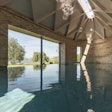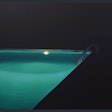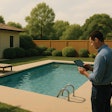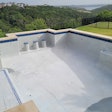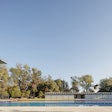

For master aquatics designer David Tisherman, the world of art and architectural history holds infinite examples and inspiration for today's designers looking to place their own work in a category above and beyond the status quo.
It's funny sometimes, the way that true inspiration can come along when you least expect it. That happened to me late last year when a group of students tossed an epiphany my way during a course I was teaching on perspective drawing in Dallas.
For starters, the class was comprised mostly of young people entering the industry, many of whom came to the process with various levels of higher education under their belts. I've always enjoyed working with younger people, especially those who appreciate the value of education and are unabashed in their thirst for knowledge. They're enthusiasm can be infectious and for the most part they're not yet jaded by years of experience and therefore don't come to the classroom thinking they already know everything, something we need much more of in this industry.
What really sparked my own enthusiasm in this case, however, was what happened after class was over and everyone went back home. In reviewing the students' comments about the program, a surprising number of them in different words essentially pressed the same question about art and specifically how to approach the creative process.
Higher Minds
The nature of art and human creativity is a subject that has been debated, considered and examined throughout recorded history by minds much greater than mine. By way of my own experience, for all that it's worth, I've come to believe that in order to begin cultivating any type of artistry, you first have to recognize why it's at all important in the first place.

In other words, you have to answer for yourself why being artistic matters. And more to the specific point, why is "the visual" so important?
As I've mentioned before, I see the work we do in the aquatics industry as having three primary components, a triumvirate I call the ABCs: "A" for art, "B" for business and "C" for construction. Back in the October issue, I started the discussion covering my views on the business component of that construct and made the point that you have to master all three to be effective at what you do if you want to create beautiful bodies of water.
So why are the aesthetics as important as the business and construction aspects of our profession? You can build a pool or spa that has absolutely nothing artistic about it on any level, and probably make money on it. In fact, one might accurately say the vast majority of pools and spas have very little or absolutely nothing artistic in their composition at all. And make no mistake, over the years, I've run into no shortage of people in our industry that seem to take pride in scoffing at "all that artsy crap." After all, real men who dig holes, set steel and work with concrete don't care or need to know about Monet, Picasso or Michelangelo, right?
At this point, I'll spare you one of my patented screeds about the moronic mentality that has plagued our industry for generations, other than to say it's exactly that kind of "ignorance is bliss" mentality that has held us back for far too long.
More to the point, the reason that artistry matters boils down to the simple and undeniable fact that human beings are visual beings. Art matters for the exact same reason that movie stars are physically attractive, why we like to live in beautiful homes, drive cars that not only run great but look good too. It's why we enjoy wearing fine jewelry and stylish apparel, why the presentation of our food matters, why we style our hair, paint our walls, grow and arrange flowers, enjoy looking at sunsets. Art matters for the same reason that smiling is a great way to communicate without speaking, it pleases our visual sense.
Can you imagine a world where we all wore the same clothes, where women had to wear the same style shoes and men the same type of watch? It would be awful, because ultimately as a species we are concerned with aesthetics. Whether we know it or not, we value design.

As we move through our days, without knowing it, we constantly judge things based on their appearance. The well-dressed shop clerk makes a very different impression than someone behind the counter who is disheveled and looks like they need to be introduced to a comb, soap and water and an iron. The home that is well kept with fresh paint, a manicured yard and tasteful window treatments is far more inviting than one with weeds and a rusting car in the front yard.
Certainly, art is not limited to the eyes — music, perfume and fine foods prove that — but there simply can be no argument that objects of beauty take on greater value in the human psyche. And art is not always simply about beauty. In its highest forms art provides commentary about the world around us, often speaking to our most precious thoughts and feelings about spirituality, society, love, history, sexuality, power, need, ambition, wealth and, of course, nature.
In that sense, the study of art history — to which I would add the history of architecture — can be rightly viewed as a companion text for the human experience. The cave paintings of Lascaux, France, give us perhaps the clearest insight into what life was all about for prehistoric people living in that region, just as the works of modern artists such as Alexander Calder speak volumes about the nature of creativity and thought in the 20th Century.
Keyed In
It's at this point in the conversation where the cynic in some people will kick in and press the question again. After all, it's all well and good to indulge such high-flown intellectual discussions, but to what practical end?
To my mind, here's where things get really interesting. Understanding design in all its facets is one of the most practical things we can do to prepare for success. On the most basic level, design means that the creative decisions we make happen for a reason. Every line we create, every color we choose should be based on specific principles. Understanding design and the world of art gives us the tools we need to make choices to fit together. Let's break it down:
First, when meeting with clients, it's crucial to figure out what they like, otherwise how can we possibly design anything that stands a chance of appealing to their tastes? That's why whenever I drive onto a property and walk into a home, I'm immediately scanning the scene for works of art, not only in the paintings or photography on the walls, but the style of furniture, their tastes in color, the fabrics they choose for their drapes, the style of their cabinetry, choices in flooring, the tile they've chosen for their kitchens – all of it yields important clues as to their likes and dislikes.
They might have a taste for classic Greco/Roman styling evident in the architecture of their home, or a love of modernist paintings of Mark Rothko or the abstract expressionist sculpture of David Smith. In these previous choices the clients are indicating the decisions they'll favor as you work together toward a design.
But if you don't have a working knowledge of art and architecture, all those signals might just fly on by you as if they weren't there.
Add to that, when you can discuss art in a meaningful and reliable way, you have an opportunity to bond with the clients and reinforce your own credibility in their minds. You don't have to be a psychologist to recognize the fact that people appreciate it when others understand and value their taste. Plus, when you comment on a particular piece, there's a good chance that you'll elicit further comment from them. Perhaps they acquired a copy of Picasso's most famous sculpture, "The Goat," or a tapestry in a market in Italy or a piece of Stickley furniture in shop in western Pennsylvania.
In my case, I long ago decided to cater to an affluent clientele. Why exactly is the subject of another discussion altogether, but as it applies here, there's no escaping the fact that people with money often are those who travel, are themselves educated and often have developed sophisticated tastes in art. The more you know about the world of art, the greater the number of opportunities you'll have to communicate with potential clients, especially those in the upper echelons of society, and the more fuel you'll have for your own creative process.
The practical fact is, people who appreciate art by and large want to know that they'll be working with those who also have similar levels of knowledge and appreciation. In that sense, revealing your background in art is a great way to establish credibility and will likely place you ahead of the competition in the clients' eyes.

Expanding Choices
By itself, that's reason enough to regard art as an important part of your professional acumen, but having a background in art takes on even greater significance when it comes down to the work itself. As I mentioned at the top of this discussion, I was teaching a course on drawing and presentation that prompted thoughtful queries from those in attendance.
I love teaching people how to draw because I see it as the best way to unlock visual creativity. Any form of artistic creation requires mastery of a given set of tools. For sculptors it's chisels and hammers or torches and saws, for musicians it's music theory and the ability to play their chosen instruments, for the writer it's words, sentences and paragraphs.
Because building pools and spas of any type is largely a visual medium, it behooves us to be able to render the design on paper. Just as architects sketch and model their designs, we too much first reveal our ideas in a preliminary form before they're built in concrete, steel and stone. Of course, these days, CAD programs are all the rage and provide a shortcut to actually being able to draw. I personally come from the old-school mentality that values being able to draw with your hands. Sure, computer-driven designs can be extremely useful and artistic, but without an understanding of visual composition, all the technology in the world means nothing.
When you can sketch effectively, you're able to work on ideas with clients instantly, without the limitations of a computer program. You can use thumbnail sketches to communicate details with installers or suppliers. To my mind, it's the best way to refine and communicate ideas.
Through drawing, we can begin to understand crucial issues of scale, dimension, perspective, line density, texture and color. Even if you primarily rely on computer renderings, you'll be far more effective using those tools if you first understand the fundamentals of drawing, whether the work is generated using pencils or on a plotter.
Taking the argument one final step further, understanding design is how you fuel the choices you make in the design process. It's the only way to make things harmonize and visually fit together. If, for example, the clients live in a beautiful Spanish Colonial home, how do you know what materials to use, or what geometrical shapes are consistent with that type of architecture? If a home has Romanesque features and the clients want columns surrounding their pool, which type of column do you choose? What type of arch is consistent with Gothic architecture or Islamic architecture? What type of stonework or plantings would you use with Japanese design, or what type of color scheme would you choose in an African-influenced scheme?
The problem with remaining ignorant is that you don't even know what you don't know. Scores of ideas and creative opportunities will fly by you while you toil unaware of the richness that's available to you, if you only had the knowledge to recognize those points of creative connection.
One of my greatest criticisms of the rank-and-file pool and spa industry has been that our creative choices have been badly limited by the offerings of manufacturers who view their wares as retail commodities rather than parts of the artisan's palette. That's why for so many years, we've only seen a small set of tile patterns or deck treatments. Our collective ignorance has empowered those who supply our products to limit our choices.
By understanding art, those choices expand exponentially simply because your own universe of ideas broadens. And, as we demand a greater sets of choices, those who supply will, over time, follow suit.
Farther On
It is true that over the past decade or more, things have changed for the better. You see it, for example, with the variety of glass tile products that are now commonplace. Our choices in stone, plaster and pebble surfaces have expanded rapidly. The very shapes of custom pools have become more creative and there are now far more people aware that using water as a design element means understanding that water always takes on the color, shape and character of the materials and structures you use to contain it.
Things are better, but we still have a long way to go if we want to elevate aquatic design and construction to the status of a true art form. When I look at the industry now compared to 20 years ago, it's clear that people with design education and a background in art are playing a much bigger role. Landscape architects, architects and even some fine artists are using aquatic environments as a canvas for truly beautiful works, designs that qualify as great works of architectural art.
At the same time, we also see a large number of people more or less pretending to be designers — without the benefit of actual education — attempting more ambitious works. (Some of those efforts are among the worst monstrosities yet and they'd probably be better off sticking to blue waterline tile and out-of-scale waterfalls.)
I believe the way forward is clear: if you want to make great art, then you have to study both the history and traditions of art and develop your own vocabulary and skill sets. And while studying design is essential, you can take your understanding to another level by traveling and seeing in person Moorish or Islamic architecture, Italianate or Asian gardens. You'll see and experience things that simply cannot be fully appreciated or embraced from afar.
Being an artist requires sacrifice and discipline. Even if you have exceptional aesthetic aptitudes, you have to commit to the process of developing the skills needed to unlock your true potential.
The first step – acknowledge that as long as people have eyes, art matters, that every line must exist for a reason and every space must be carefully designed.
Comments or thoughts on this article? Please e-mail [email protected].


































